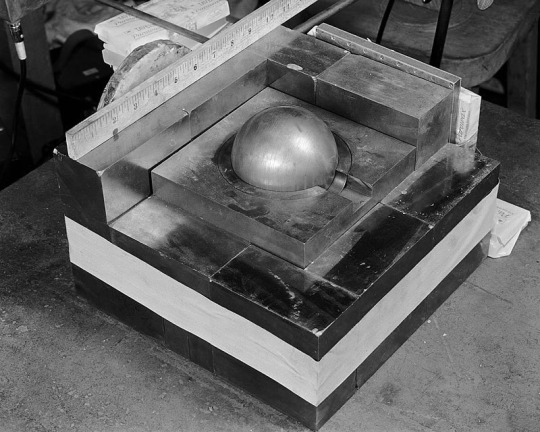#radiation
Text
It's Elephants Foot Friday!!!!
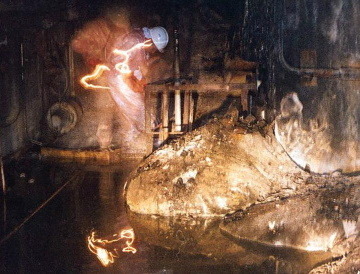
RB to instantly receive 8000 roentgens of radiation
25K notes
·
View notes
Text
I got a Geiger counter!
Let’s look through my collection for some Spicy Rocks! I’ve never deliberately collected radioactive specimens, so I have no idea what I’m going to find.
First, though, let’s test the baseline level of radiation in my house.

It’s fun to hear the Geiger counter click as it detects radiation. 20 counts per minute. Nice! You’re unlikely to ever see a count of zero, as pretty much everything in the world, including the human body, gives off a little bit of radiation.
20 is a normal baseline, nothing to be concerned about. Standing in my house, I’m getting a radiation dose of about 0.00013 milliseieverts per hour - or a little over one mSv a year. This is an average yearly dosage of radiation for people in my country, and is something my body can easily process. For context, a dosage of 100 mSv would slightly increase my risk of cancer, and a dosage of 1000 mSv would immediately give me radiation sickness.
But enough about these boring, safe amounts of radiation. I want to see some spice! Let’s check over by the Rock Wall!

Hm, I’d expected the CPM to be noticeably higher around my rock collection, but I’m getting nothing! Even testing each individual rock, nothing’s more than a few ticks above the baseline. So far, my fancy new toy is looking like wasted money. :c

WAIT! THERE!! 62 CPM! That’s three times higher than the base reading in the rest of my house!!! YESSS!! THIS ROCK IS SPICY!!!!


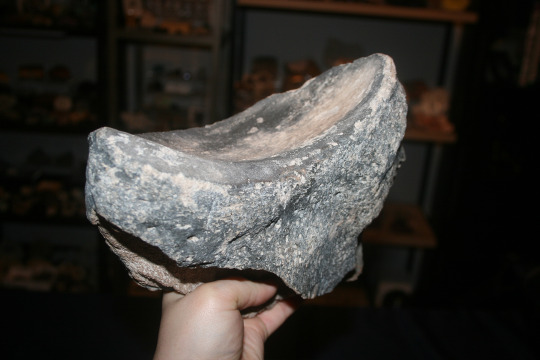
Here’s the rock that’s setting off my Geiger counter. (Yes I’m touching the spicy rock with my bare hands, don’t worry about it.)
This fossil, which is as big as my head, is part of the femur bone of a Megalonyx, a North American giant ground sloth!
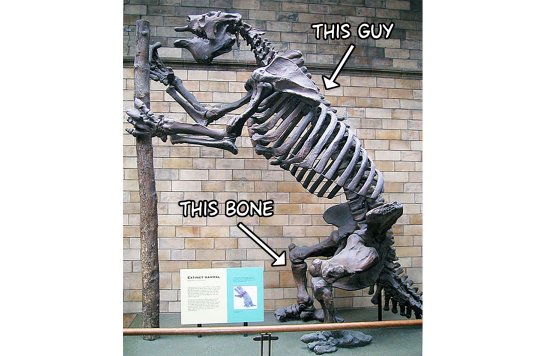
These huge animals could grow as big as ten feet tall. They lived alongside humans during the last ice age, and it’s theorized that humans may have hunted them to extinction. This particular fossil was found in a phosphate mine!
Why is it radioactive? Because... sometimes fossils are just radioactive! They spend a lot of time in the ground, which is full of radioactive minerals, and often radiation just gets all up in there. There are some fossils on display in museums which are so radioactive that they have to be coated with lead paint for the safety of curators and museum-goers! Compared to those, this femur bone is barely radioactive at all.
So is it really safe for me to have this in my house, much less handle it with my bare hands? Well, yeah! Remember, despite having this spicy rock in my collection, the radiation baseline in my house is completely normal. Here’s why.
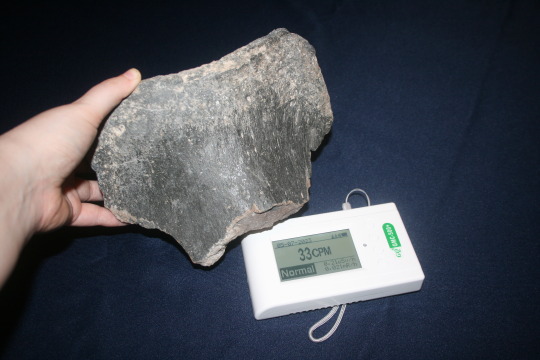
Even just a few centimeters away from this specimen, the Geiger counter’s reading is halved. A few inches away, and it can’t detect any radiation at all. It basically has to be directly touching the rock to get an abnormal reading. Which means I also have to be touching the rock to receive a meaningful amount of radiation exposure.
But even holding this rock in my hands, I’m only getting a dosage of about 0.0004 mSv per hour. If I never let go of this rock for an entire year, I would get a dose of about 3.5 mSv. Which is... still completely within the safe threshold for my body to process. Nothing to worry about!
Man, I gotta start collecting some spicier rocks.
#rock collecting#red pen has cool rocks#fossils#north american giant ground sloth#geiger counter#radiation
4K notes
·
View notes
Text
why are geiger counters so cute. they are like little animals to me. making cute little noises when they detect radiation.
#mine#shitpost#geiger counter#radiation#radium#uranium#uranium glass#little animals#cute aggression#they are cats to me
2K notes
·
View notes
Text
Wait hang on you guys, you know when Nona dies in Ntn how her body and organs split at the seams and her skin kinda starts to slough away? That’s like strikingly similar to what happens to people with acute radiation poisoning i.e. nuclear weapons. Irradiated soul Alecto causing Harrow’s body to fall apart?
#gideon the ninth#harrow the ninth#gideon nav#harrowhark nonagesimus#the locked tomb#alecto tlt#alecto the first#alecto the ninth#alecto speculation#alecto predictions#alecto theories#nona#nona the ninth#nona tlt#nona the 9th#harrow the 9th#harrow the first#harrowhark the ninth#the body#radiation
793 notes
·
View notes
Text
Interesting fact I think you didn't know (and which I've learned from my chemistry teacher that worked in different branches of the industry his entire life):
Czech people are kind of radiation resistant because we literally live on radioactive soil (the entire country is filled with uranium. When Marie Sklodowska Curie discovered radiation, she was using Czech uranium).
And that's also why we handled the Chernobyl radiation so well - we're used to it and basically immune to it.
That's right folks, Czechs are basically radioactive
#čumblr#czech#chemistry#science#fun facts#czech republic#uranium#radiation#Maybe that's why we're so toxic? Haha#I'm sorry but the pun opportunity was right there
2K notes
·
View notes
Text
Stained glass windows in the administrative building of the Chernobyl nuclear power plant.







The Chernobyl Nuclear Power Plant was one of the largest in the Soviet Union and the poster child of the Soviet nuclear power industry. As such, little expense was spared on details like these windows.
The Soviet Union often used motifs in abstract art to promote Communism and laude their successes.
For more info, check out my reblog of this post.
#chernobyl#socialist realism#soviet union#ussr aesthetic#soviet art#ussr (former soviet union)#nuclear power#radiation#accidents and disasters#1k#2k#history#reactor#disaster#stained glass#nuclear#propaganda#soviet propaganda#autism#ussr art#chernobyl hbo#chnpp
4K notes
·
View notes
Text

Magic as radiation
A power that can heal when channeled into a fine point
A power that can kill just by standing too near
The unicorn as an untouchable animal impossible to capture
The unicorn as an elephant's foot
The enchanted forest as a territory ruled by a magical creature
The enchanted forest as an irradiated waste
The maiden as the one that allows the unicorn to come close and rest in her lap
The maiden as a willing human sacrifice
2K notes
·
View notes
Text



Top looks in the ShopShifty store this week:
Moth Man | Have you hugged your computer? | Co-60 Fan Club
#moth man#computers#radiation#our shirts#mothman#thank you for supporting indie disabled queer nonsense
391 notes
·
View notes
Text


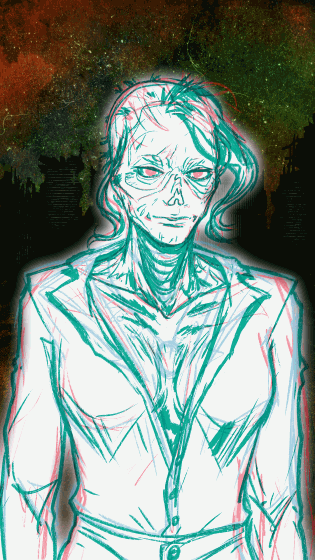




I'm having a blast working on this gift commission of Whiskey by Koilartist (gifted by Krokaxe!) They are both such lovely, amazing artists, I feel like I've been following them/their work on Tumblr since I got on here, so I am ECSTATIC to be drawing this gal!
I still have plans to draw some jewelry for her and finish up the detailed work. I am so happy with how this is turning out, and I LOVE doing the glowy-radiation effects (❁´◡`❁) She's such a cool character to draw!
#whiskey#ghoul#fallout ghoul#fallout 3#fallout new vegas#fnv#fonv#fallout#work in progress#clip studio paint#animation#csp animation#radiation#tw flashing#just in case#gif#progress shot
481 notes
·
View notes
Text
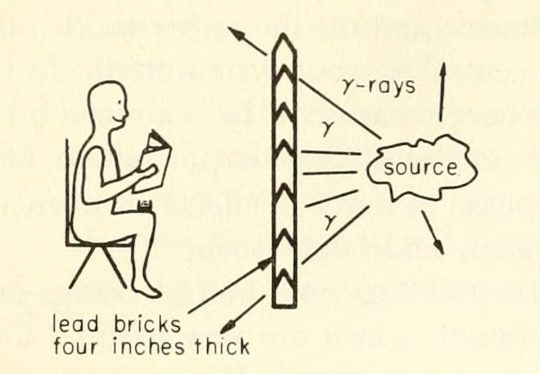
Radiation won't penetrate a lead wall. Biophysics. 1962.
Internet Archive
#diagram#radiation#radioactivity#lead shield#nuclear physics#hazards#textbook illustration#science#nemfrog#1962#1960s
866 notes
·
View notes
Text
Deep Water Prompt #3272
The nuclear energy plant is staffed almost entirely by ghosts. They work for free in exchange for access to radiation. They feed off it, memories returning, sometimes becoming almost corporeal.
151 notes
·
View notes
Text
#homestuck#dirk#dirk strider#john egbert#rose lalonde#roxy lalonde#jake english#jade harley#dave strider#jane crocker#radiation poisoning#radiation#alpha kids#beta kids
206 notes
·
View notes
Text
No but for fucking real I hate the "this is not a place of honor" warning like if future humans have enough know-how to translate the entire message into whatever future language has developed by then they can damn sure translate the damn word "RADIATION"
320 notes
·
View notes
Text
Wet Beast Wednesday: tardigrades
Last week on Wet Beast Wednesday I covered the largest animals to ever exist on our planet. This week I'm going to pull a full 180 and cover the smallest animals yet on this series. Meet the tardigrade, the internet's favorite micro-animal the is said to be basically immortal. How true is that? Let's see.

(Image: an electron microscope image of a tardigrade. It looks a lot like a potato with eight stubby legs tipped with long claws. At the front is a small, circular mouth. It has no other discernable features. In the background are bits of plant matter that look like seaweed at this scale. End ID)
The tardigrades are 1,300 known species (and probably a lot of unknown ones too) in the phylum Tardigrada. They are also part of the superphylum Ecdysozoa, which are animals that grow by molting their outer cuticles or exoskeletons. In particular, the tardigrades are believed to be a sister group of the arthropods, the group that contains crustaceans, insects, isopods, and a lot of other things. Tardigrades are truly tiny, the largest species reaching a whopping 1.5 millimeters in length, though most species reach no more than 0.5 mm. They have round, segmented bodies with four pairs of legs that end in either claws or suction discs. The body segments consist of a head, three body segments with a pair of legs each, and a caudal segment with the final pair of legs. The first three legs are used for movement while the final pair points backwards and is used for grabbing onto substrate. All of the body segments except for the final one correspond to segments found in the head section of insects. Tardigrades are missing many hox genes, genes that direct the body plan during development. Their ancestors may have had a body plan more similar to insects, but the loss of the hox genes has compressed them into walking heads with a bit of butt. The mouth is tubular and sucks in food. In the mouth are stylets, needle-like structures used to pierce food objects. Once food is drawn into the mouth, a structure called the buccopharyngeal apparatus activates. This is a combination of spines and muscle that acts like an inner jaw that pulls food into the digestive tract. The buccopharyngeal apparatus is distinct enough to be used as a major identifying feature between species. Tardigrades are translucent and many images you've seen of them have false color to show the details or are 3D models based on scanning electron microscope imagery of them. Tardigrades molt their exoskeletons multiple times (up to 12) during their lifecycle. Some species are unable to poop normally and instead all their waste is discarded during the molt. It was formerly believed that tardigrades could exchange genes with each other without mating, a process called horizontal gene transfer that is seen in bacteria, archaea, and other micro-organisms. It has since been discovered that while still capable of horizontal gene transfer, it is quite a bit rarer in tardigrades than we thought.
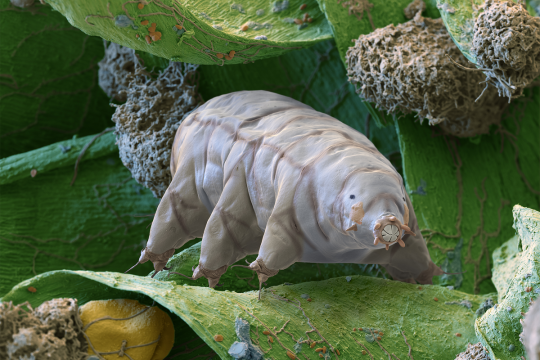
(Image: an electron microscope image of a tardigrade standing on a bit of plant matter. This one has a closed mouth with a ring of triangular tooth-like structures. It also has two simple eyes that look like black dots. End ID)
The name "tardigrade" means "slow walker", which is fitting as, despite their eight legs, tardigrades have a slow and awkward gait. This is the result of their legs being unjointed, only able to pivot at their connection to the body. Their gait has been compared to that of bears, hence why they are often called water bears and their discoverer, Johann August Ephraim Goeze, called them "kleiner wasserbär", meaning "little water bear". Tardigrades are found worldwide and have inhabited virtually every habitat, from the tops of mountains to the deep sea, from hot springs to the antarctic, from freshwater to saltwater. The one thing they have in common is a need to stay wet. Tardigrades can survive out of water as long as they can stay moist and are often found in mosses, hence another common name: moss piglets. The majority either eat plants or bacteria, but some will feed on smaller tardigrades or other micro-animals. Their famous survivability makes it easy for tardigrades or their eggs to be carried to new habitats by larger animals or other phenomena. Tardigrades are one of the first micro-animals to colonize a new habitat and they are a pioneer species, the first species to colonize a new environment and whose presence makes that environment fore suitable for other species to follow. Tardigrades are a major food source to other micro-animals and larger organisms. Most species have distinct males and females, though a few reproduce through parthenogenesis. In most cases, molting female will lay her eggs in her shed cuticle and males will them fertilize them. Other species have a form of internal reproduction. Males and females will court each other before mating and females will usually allow multiple males to fertilize her eggs. Female tardigrades are typically larger and more abundant than males. Eggs can take up to 14 days (species dependent) before hatching. All tardigrades of the same species have the exact same number of cells as each other. They are also born with the same number of cells they will have as an adult. Their growth is driven by enlargement of the existing cells rather than cellular reproduction making new cells. The lifespan ranges between a few months to a few years, depending on species.

(Image: a color photo of a tardigrade. It is a pale, translucent white, making it hard to make out details. Its body is curved, with the front end pointing at the camera. It has two simple eyes. End ID)
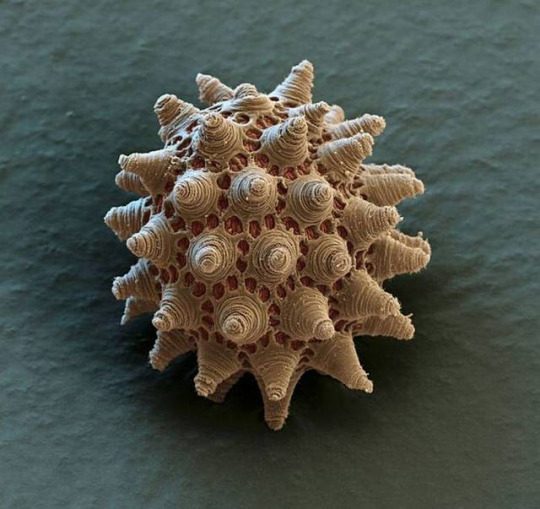
(Image: an electron microscope image of a tardigrade egg. It is round but covered in small pores and conical structures. End ID)
The most famous feature of tardigrades is their legendary durability. It is commonly said that tardigrades can survive just about anything (except for the things that are actually trying to kill them. They are prey to a lot of species after all). Among the things they can survive is extreme heat, extreme cold, dehydration, extremely high and low pressure, exposure to ionizing radiation (that's the scary kind), low oxygen environments, environmental toxins, heavy impacts, and the vacuum of fucking space. While the can survive in extreme conditions, tardigrades are not considered extremophiles. True extremophiles thrive in extreme environments and are negatively impacted by leaving them. Tardigrades can survive in extreme environments, but are negatively impacted and can't survive as well there as they can in less extreme places. The main trait that has allowed tardigrades to survive all five mass extinctions in history is cryptobiosis. Cryptobiosis is the rare ability for an animal to enter a state of dormancy where their metabolic processes come to an almost complete stop. While in cryptobiosis, metabolic activity drops to 0.01% normal and water content drops to 1% normal. In this state, the tardigrade is called a tun. Tardigrades usually enter cryptobiosis in response to arid conditions. One experiment showed that a species of tardigrade could last for at least 30 years in this state and return to normal lifestyle functions when exposed to water. Tardigrades will also enter cryptobiosis in response to low oxygen, toxic chemical exposure, increased or decreased temperature, and excessive salt content in the water. Tardigrades also show extreme resistance to both high and low pressure. They can live in 0 atmospheres of pressure and some species can survive up to 6,000 atmospheres, more than double the pressure at the bottom of the Marianas trench. More interesting is their ability to survive dangerous radiation. They can survive 1,000 times the dose of gamma radiation that humans can. Early tests focused on tardigrades in cryptobiosis and concluded that the extremely low water content of a cryptobiotic tardigrade doesn't leave much opportunity for the radiation to react with the animal. However it was later found that active and fully hydrated tardigrades are still considerably resistant to radiation. Studies into this resistance indicate that tardigrades can very efficiently repair damaged DNA and have unique proteins called Dsup that provides additional protection. Dsup introduced to human cells has provided additional protection against x-rays.
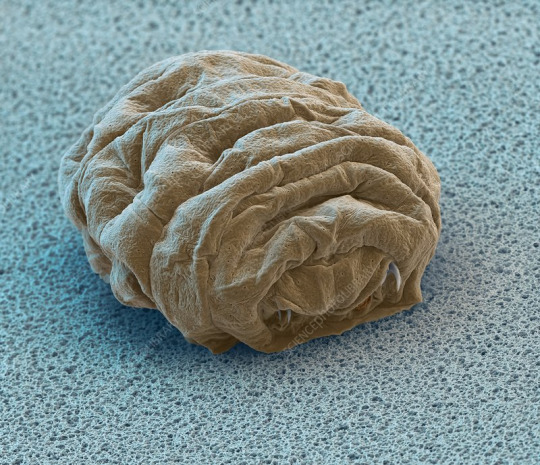
(Image: an electron microscope image of a tun - a tardigrade in cryptobiosis. It is smaller and very wrinkly, with the legs and mouth retracted into the body. End ID)
Tardigrades were the first animals to be exposed to the vacuum of space. They were exposed for 10 days, some in a state of cryptobiosis at the time of exposure and some still active. It was found that they were able to survive the vacuum when shielded from the sun's ultraviolet radiation, with those already in cryptobiosis doing better. Upon being rehydrated, many were able to resume normal life functions and successfully reproduce, though others died after being rehydrated. Those that were exposed to UV radiation fared much worse, with only a few hydrated individuals surviving. The individuals in cryptobiosis had a lower survival rate when exposed to UV than those not exposed to UV and were less successful at reproducing afterwards. Studies of tardigrade's space survival abilities and resistance to radiation could go a long way in helping human space travel. One of the largest dangers of space travel is that space is full of nasty radiation from the sun that Earth's magnetic field protects us from. Some scientists speculate about the possibility of accidentally seeding other planets or moons with tardigrades or other space-resistant organisms. This is a problem because introducing Earth life to other world has the potential to damage any native ecosystems and if we find life in space in the future we don't want to have to figure out if it's something we accidentally put there. While tardigrades could likely survive on other planets, they would eventually die without a food source. Some sources reported that tardigrades may have colonized the moon after an experiment with them crashed. Unfortunately, the moon is not crawling with tardigrades now. It's way too dry for them to exit cryptobiosis even if they survived the crash, which they probably didn't.
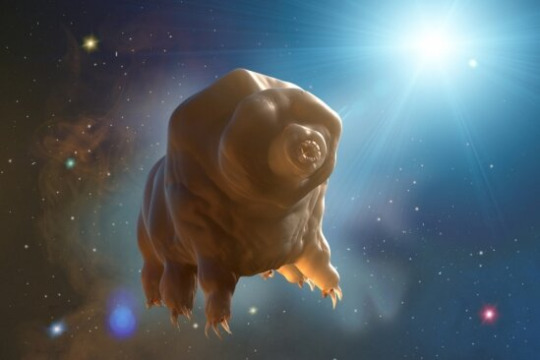
(Image: art of a tardigrade floating in the vacuum of space. End ID. Source: University of California - Santa Barbara)
#wet beast wednesday#tardigrade#water bear#moss piglet#micro animal#microbiology#marine biology#biology#zoology#ecology#animal facts#informative#science#space#astrobiology#radiation#cryptobiosis#tun#image described
155 notes
·
View notes
Note
ask for infodump about Chernobyl as someone who has never even heard of it
INHALES
Chernobyl is considered to be the worst nuclear disaster in history, rated at a 7 on the International Nuclear Event Scale (INES), the only other disaster ranking at a 7 being in Fukushima back in 2011. The disaster occurred on April 26, 1986. The Chernobyl Nuclear Power plant was located in Ukraine, which was under the control of the Soviet Union at the time. It was only about 16 miles from the Belarus-Ukraine border, which was also under Soviet control. There were two main towns nearby, Chernobyl itself, which was older, had only about 15,000 residents, and was actually farther from the Chernobyl Nuclear Power Plant than Pripyat, which had about 50,000 residents, and was only about 2 miles from the plant. Pripyat was newer, and residents had an average age of about 26. The town itself was filled with young, well educated people starting new lives. A large number of public buildings were located in Pripyat, including a school and a sports complex, which contains the famous Azure Swimming Pool. The plant supplied Pripyat with energy, and the place was considered a sort of "dream city." The plant was an RBMK-1000 type reactor, a generation I nuclear reactor, which are the earliest, and generally most hazardous, nuclear reactors. RBMKs were used to produce Plutonium, a radioactive material primarily used in nuclear weapons. However, they could also be used to produce civilian energy, so a few were constructed to supply parts of the USSR with power. At the time of the incident, there were four reactors in operation, with reactors 5 and 6 under construction. A test was scheduled to be conducted to see if the backup generators could successfully turn on in time to keep the cooling systems running at safe levels. However, the test was delayed until the less experienced night shift was in. They turned off the reactor's shutdown feature and lowered the power to the reactor. Reactors need energy to function, as they have to be cooled. For these reactors, large amounts of water were used to cool them. Without the shutdown function, the reactor was in danger of overheating if it wasn't cooled. Regardless, they ran the test. When the backup generators took too long to turn on, panic set in, and the reactor began to overheat. Then, somehow hit the AZ-5 button, which lowers all control rods into the reactor at once. Control rods are used to absorb excess amounts of shed neutrons from the nuclear reactions. However, they momentarily increase reactions when first introduced into the reactor chambers. The undertrained staff of the night shift were not aware of this. With the increased reactivity, the reactor was now dangerously hot, and the casinging around the fuel rods began to rupture, causing white-hot radioactive fuel to come into direct contact with steam. At 1:23 A.M., April 26, 1986, Chernobyl Nuclear Reactor #4 exploded. The contact between the fuel and the steam caused a steam explosion, blowing the 1000 tonne reactor roof into the air and spewing radioactive debris and particles into the air.


Two plant workers were killed instantly by either the force of the blast or from being hit by debris. Although plant workers realized what had happened rather quickly, superiors were slow to act. Firefighters were called in, but they were not told the dangers of the radiation. Most died within a few months. But that was only the tip of the iceberg. In Pripyat, the Amusement Park that had been scheduled to open the next day was hurriedly opened a day early to distract residents from the fact that the reactor was on fire.

It took 36 hours for Soviet Officials to finally begin to evacuate Pripyat, only after residents had begun to report nausea, dizziness, fatigue, vomiting, and headaches, all symptoms of radiation poisoning. A few weeks earlier, citizens were trained with gas masks in case there ever was an incident. Officials said that they didn’t need them, as they didn’t want to cause a panic.
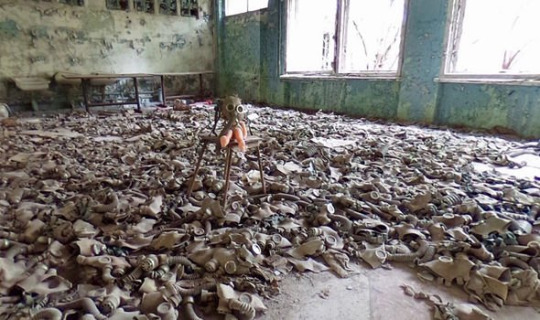
Residents were also told they would be returning soon, and to leave everything behind. They did not come back. This left Pripyat as an eerie ghost down where everything seemed to have simply been dropped and left. Today, it is still abandoned, and is being slowly reclaimed by nature.
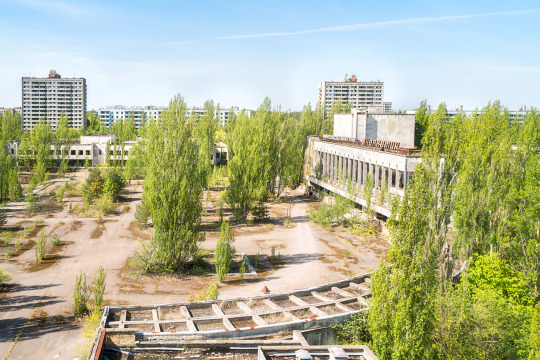
During the cleanup of the incident, “Liquidators” were called in. Some knew the dangers, others didn’t. The fire of the reactor was too hot to be put out by water, so tons and tons or boron, sand, and lead were dumped onto the burning reactor by helicopters that flew over. It didn’t help much, and the reactor finally stopped burning after about 2-3 weeks. A structure dubbed “The sarcophagus” was built over the reactor to contain the radiation, though it was rushed and leaked radiation. A large area of woodlands was contaminated by the radiation, and it turned red and died, earning the nickname “The Red Forest.” Most of these trees were cleared and buried. Highly contaminated houses were knocked down, animals were shot, and crops destroyed. Absolutely everything that was highly contaminated was at least attempted to be destroyed and buried. Still, not everything could be destroyed and buried, there was simply too much. One object, dubbed “The Claw of Death” was, according to conflicting accounts, either used to assist in the overall cleanup or was used specifically in the cleanup of the plant roof. It is radioactive enough to give a lethal dose if sat in for about 11 hours.

Another rather infamous object is “The Elephant’s Foot” which is a mass of sand, concrete, and melted reactor fuel that had melted its way through the floor and down into the basement. Upon discovery, the sheer amount of radiation it gave off was enough to give you a fatal dose within about 90 seconds. Today, that’s increased to about five minutes. The foot was unyielding to sampling tools, so, they shot it with a Kalashnikov Rifle (AK-47) to get a sample.
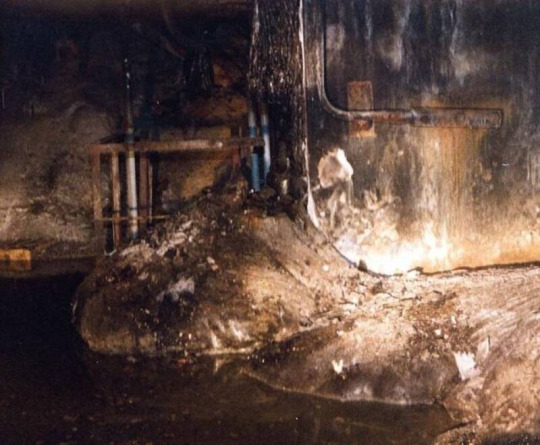
After a very short period of time, the remaining three reactors were up and running again, as the USSR simply needed power desperately. By December of 1987, all three reactors were up and running again. They were operated for years, until the last reactor was finally shut down for good in 2000. Being so close to the border, and with the wind conditions of the time, mass amount of radioactive particles were blown north to Belarus. The Soviet Union had planes fly over and seed the clouds with chemicals, forcing them to rain on rural land instead of heavily populated areas, but this still had a major effect, as about 1/3 of Belarusian farmland was contaminated. However, the winds began to shift, blowing radiation towards Europe. Sweden was the first to sound the alarm, asking if something had happened after detecting dangerous amounts of airborne radiation and determining it was not from any of their own reactors. The USSR finally admitted there had been a “very small” incident at Chernobyl, and was very reluctant to give the world information. Careful monitoring protocols were put on resources everywhere in Europe, from grain to milk to wood, all were carefully measured for radiation. Years later, after the Sarcophagus was determined to be unsafe, the New Safe Confinement unit was constructed, which is a semicircular dome over the existing Sarcophagus. The New Safe Confinement was finished in 2018.

DONE!
(For now)
@not-wizard-council-aristocrat @anarcho-neptunism @siley-the-wizard @villainessbian
143 notes
·
View notes
